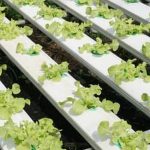Hydroponic vegetable gardening has been gaining popularity as an innovative and efficient way to grow produce. Many people are curious about this method, and one of the common questions asked is, “Are hydroponic vegetable gardening expensive?” In this article, we will explore the costs associated with hydroponic vegetable gardening and compare them to traditional soil-based gardening methods.
Hydroponic vegetable gardening involves growing plants without soil, using nutrient-rich water solutions instead. This method allows for greater control over plant growth and can result in higher yields compared to traditional gardening. As we delve into the benefits of hydroponic vegetable gardening, we will also examine whether the potential expenses are worth it.
In the following sections, we will provide a detailed comparison of costs between traditional gardening and hydroponic gardening. Factors affecting the expense of hydroponic vegetable gardening will be analyzed, along with a breakdown of costs related to equipment and setup, as well as nutrients and maintenance.
Additionally, we will share practical tips for saving money while engaging in hydroponic vegetable gardening. By the end of this article, readers will have gained valuable insights to determine if hydroponic vegetable gardening is a worthwhile investment.
Benefits of Hydroponic Vegetable Gardening
Hydroponic vegetable gardening offers a plethora of benefits that make it an attractive option for enthusiasts. Here are some of the advantages of hydroponic vegetable gardening:
- Faster Growth: One of the biggest benefits of hydroponic vegetable gardening is the rapid growth of plants. Without soil, plants have direct access to nutrients, allowing them to grow up to 25% faster than their soil-grown counterparts.
- Water Efficiency: Hydroponic systems use significantly less water than traditional soil gardening. This is because the water in a hydroponic system is recirculated and reused, while soil-based gardens lose water through evaporation and drainage.
- Space Savings: Hydroponic systems can be set up vertically, allowing for more efficient use of space. This makes them perfect for urban gardeners or those with limited outdoor space.
Moreover, hydroponic vegetable gardening also reduces the risk of pests and diseases that are commonly found in traditional outdoor gardens. The controlled environment of a hydroponic system minimizes these risks, reducing the need for pesticides and other chemical treatments.
In addition, since there is no reliance on soil, hydroponic vegetable gardening can be done in any location regardless of the quality or type of soil present. This opens up opportunities for individuals in areas with poor soil quality to grow their own fresh produce without the need for expensive amendments or soil testing. These benefits make hydroponic vegetable gardening a cost-effective and sustainable option for many individuals who are looking to produce their own food at home.
Comparison of Costs
When it comes to comparing the costs of traditional gardening and hydroponic gardening, there are several factors to consider. Traditional gardening involves the use of soil, which can be relatively inexpensive, especially if you have access to nutrient-rich soil in your area. However, there are also costs associated with purchasing gardening tools, fertilizers, and pesticides for traditional gardening.
On the other hand, hydroponic vegetable gardening does require a higher initial investment compared to traditional gardening. The cost of setting up a hydroponic system can be significant, as it involves purchasing equipment such as grow lights, reservoirs, pumps, and growing medium. Additionally, hydroponic systems require specific nutrients to support plant growth, which can add to the overall expense.
Despite the higher initial investment, many enthusiasts argue that hydroponic vegetable gardening can actually be more cost-effective in the long run. This is because hydroponic systems use water more efficiently than traditional soil-based gardens and typically result in higher yields. Additionally, since plants grown hydroponically are not exposed to soil-borne diseases or pests as they would be in traditional gardens, there may be less need for expensive pesticides or fungicides.
Factors Affecting the Expense of Hydroponic Vegetable Gardening
There are several factors that contribute to the expense of hydroponic vegetable gardening. One of the primary factors is the initial setup cost, which includes purchasing equipment such as grow lights, growing medium, nutrient solution, and a water pump. Additionally, the ongoing cost of maintaining a hydroponic system can also add up over time.
Another factor that affects the expense of hydroponic vegetable gardening is the type of vegetables being grown. Some plants may require more specific nutrients and care, which can increase overall costs. Additionally, certain vegetables may have higher initial setup costs due to specific environmental requirements or growth patterns.
The size and scale of a hydroponic operation will also impact the total expense. Larger systems will naturally require more equipment and resources, leading to higher initial and ongoing costs. Conversely, smaller-scale setups may be more affordable for those looking to experiment with hydroponic gardening without breaking the bank.
| Factor | Impact on Expense |
|---|---|
| Initial Setup Cost | High due to equipment purchase |
| Type of Vegetables | Variable based on nutrient needs |
| Size and Scale of Operation | Direct correlation to overall cost |
Cost Breakdown
When it comes to hydroponic vegetable gardening, the initial cost of equipment and setup can be a significant investment. However, this cost is often offset by the long-term benefits and savings that come with this type of gardening. The most obvious expense in hydroponic gardening is the equipment needed to set up a proper system. This includes items such as water pumps, growing trays, grow lights, and a nutrient delivery system.
One of the key advantages of hydroponic gardening is that it allows you to grow vegetables in a controlled environment without the need for soil. This means that you can grow your produce year-round regardless of outdoor conditions. However, this also means that you will need to invest in quality equipment to ensure that your plants receive the nutrients and conditions they need to thrive.
In addition to equipment, there are costs associated with setting up the physical space for your hydroponic garden. This could involve building or purchasing shelving units, setting up irrigation systems, and ensuring proper ventilation for your plants. While these initial expenses may seem daunting, many hydroponic gardeners find that the investment pays off over time in terms of increased vegetable yields and reduced maintenance compared to traditional gardening methods.
| Expense Category | Estimated Cost Range |
|---|---|
| Equipment (grow lights, water pumps, etc.) | $500 – $2000+ |
| Setup (shelving units, irrigation systems) | $200 – $1000+ |
Cost Breakdown
When it comes to hydroponic vegetable gardening, the cost of nutrients and maintenance are important factors to consider. While traditional soil gardening relies on natural nutrients found in the soil, hydroponic systems require specific nutrient solutions to ensure the optimal growth of plants. Additionally, the maintenance of a hydroponic setup also incurs costs that need to be taken into account.
Nutrient Costs
One of the ongoing expenses of hydroponic vegetable gardening is the cost of nutrient solutions. These solutions are essential for providing plants with the necessary elements for growth, such as nitrogen, phosphorus, and potassium. The price of these nutrient solutions can vary depending on factors such as the type of plants being grown and the specific nutrient requirements. However, investing in high-quality nutrient solutions is crucial for achieving healthy and bountiful harvests.
Maintenance Expenses
In addition to nutrient costs, hydroponic vegetable gardening also involves various maintenance expenses. This can include the cost of replacing or upgrading parts of the hydroponic system, such as pumps or timers. Regular monitoring and adjustments may also be necessary to maintain optimal conditions for plant growth. Furthermore, there may be additional costs associated with water quality testing and pH regulation.
Strategies for Managing Nutrient and Maintenance Costs
While there are inherent expenses involved in providing nutrients and maintaining a hydroponic system, there are strategies that can help minimize these costs. For instance, purchasing nutrients in bulk or taking advantage of sales can result in significant savings over time. In terms of maintenance, proactive measures such as regular system checks and proper cleaning can help prevent costly repairs or replacements.
Overall, while there are initial investments and ongoing expenses associated with nutrient solutions and maintenance in hydroponic vegetable gardening, careful planning and smart practices can help manage these costs effectively without compromising plant health and productivity.
Tips for Saving Money on Hydroponic Vegetable Gardening
When it comes to hydroponic vegetable gardening, many people wonder if it is an expensive venture. While there are certainly costs associated with setting up and maintaining a hydroponic garden, there are also ways to save money and make the investment more affordable. In this section, we will provide some tips for saving money on hydroponic vegetable gardening.
DIY Equipment and Setup
One way to save money on hydroponic vegetable gardening is by opting for a do-it-yourself approach when it comes to equipment and setup. Many of the components needed for a hydroponic system can be constructed using inexpensive materials that are readily available at hardware stores. By building your own reservoirs, grow beds, and irrigation systems, you can significantly reduce the initial cost of setting up a hydroponic garden.
Use Homemade Nutrient Solutions
Another way to lower the expenses of hydroponic vegetable gardening is by making your own nutrient solutions. Instead of purchasing pre-mixed hydroponic nutrients, you can research and create your own nutrient mixtures using common household ingredients. This can result in substantial savings over time, especially if you have a large hydroponic garden.
Efficient Maintenance Practices
In addition to DIY equipment and homemade nutrients, practicing efficient maintenance can help reduce the ongoing costs of hydroponic vegetable gardening. This includes monitoring and adjusting nutrient levels carefully, and keeping a close eye on water usage. By staying proactive and attentive, you can avoid wasting resources and minimize unnecessary expenses associated with maintaining a hydroponic garden.
Conclusion
In conclusion, while there is an initial investment required for hydroponic vegetable gardening, the long-term benefits outweigh the costs. The advantages of hydroponic gardening, such as higher yields, faster growth, and more control over growing conditions, make it a worthwhile investment for those who are passionate about fresh produce and sustainable living.
Additionally, when comparing the costs between traditional gardening and hydroponic gardening, it is clear that the latter can be more cost-effective in the long run. While traditional gardening may seem less expensive upfront, factors such as water usage, space requirements, and yield potential ultimately make hydroponic gardening a more attractive option.
To manage the expense of hydroponic vegetable gardening effectively, individuals can employ various cost-saving strategies. For instance, utilizing energy-efficient equipment, making use of household items for setup, and buying nutrients in bulk can help reduce overall expenses. By being mindful of these tips and actively seeking out budget-friendly options, individuals can successfully maintain a hydroponic garden without breaking the bank.
When considering all of these factors together, it becomes evident that while there are initial costs associated with hydroponic vegetable gardening, it is indeed a worthwhile investment for those who prioritize sustainability and quality produce. Moreover, as technology continues to advance in this field, it is likely that the costs involved in setting up and maintaining a hydroponic garden will continue to decrease over time.
Therefore, for individuals willing to make an initial investment in exchange for long-term rewards and benefits, hydroponic vegetable gardening proves to be a valuable and rewarding endeavor.
Frequently Asked Questions
Is Hydroponic Gardening Expensive?
Hydroponic gardening can be expensive to set up initially, as it requires specialized equipment such as grow lights, pumps, and nutrient solutions. However, over time, the cost of maintenance can be lower than traditional soil gardening.
What Are the 3 Main Disadvantages of Hydroponic Farming?
Three main disadvantages of hydroponic farming include the initial high cost of setup, the reliance on electricity for lighting and water circulation, and the technical knowledge required to maintain a successful hydroponic system.
Is Hydroponics Cheaper Than Buying Produce?
In some cases, hydroponically grown produce can be cheaper than buying it from a grocery store, especially if grown at home. However, this depends on factors such as initial setup costs, ongoing maintenance expenses, and the types of produce being grown.

If you’re looking to get into vegetable gardening, or are just looking for some tips on how to make your current garden better, then you’ve come to the right place! My name is Ethel and I have been gardening for years. In this blog, I’m going to share with you some of my best tips on how to create a successful vegetable garden.





